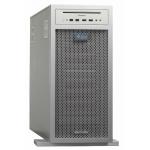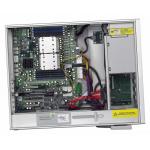Sun Ultra 40-Ready for Heavy Work
This workstation is versatile enough for heavy-duty MCAD/MCAE,simulation, and rendering jobs or it can be a server and Webdevelopment system. We gave it a try on the engineering desktop.
Latest News
June 1, 2006
By Mark Clarkson
My Sun Ultra 40 workstation showed up ready for work with twin, dual-core 2.4GHz Opteron 280s and 8GB of ECC DDR-SDRAM (the system supports up to 16GB). It also packed twin 500-GB SATA drives. (The Ultra 40 supports RAID 0 and RAID 1.)
The Ultra 40 comes preloaded with Sun Solaris 10 and a raft of developer tools including Java Studio Creator and Enterprise, Sun Studio, NetBeans, and a license for Sun’s N1 Grid Engine software. You can order Red Hat Enterprise Linux WS or SUSE Linux Enterprise Server, and the Ultra 40 supports Windows XP Professional 32- and 64-bit, although the Ultra 40 doesn’t ship with Windows installed. I tested the system using 32-bit Windows XP, my standard working environment.
 |
| Sun Ultra 40 Workstation. |
Sun sent along one of its 20.1-inch flat-panel LCD monitors. This monitor is very sweet: bright, crisp, and contrasty. I’m a CRT bigot, but this monitor looked great, even sitting right next to my 22-inch LaCie CRT. A Solid Case
I love the Ultra 40’s case; it’s big, plain, and solid. There’s no consumer frou-frou here; a single green LED on the front of the metal case tells you if it’s turned on. The front is mostly grill for better airflow. At the top are two high-speed USB and two FireWire ports, headphone and microphone jacks, a power button, and a slim eject button beneath the slot-load DVD-RAM drive.
Likewise, the back is entirely perforated grillwork except for the actual plugs, ports, and card slots. The Ultra 40 has two PCI slots, two PCIE (PCI-Express) x16 slots, and two PCIE x4 slots, as well as 5-channel sound, coax in and out, and another six high-speed USB ports. Everything’s clearly labeled (e.g. PCIE #1: ME:X16EE:X16); even the keyboard has a pointer to its online documentation stuck underneath.
The mammoth 1000-watt power supply sits at the very bottom, an unusual arrangement, but one which helps the balance of the unit and puts the power cable right on the floor or desktop.
Sun brags about how quiet this system is, but we’ve heard that before. In fact, when I first powered the unit on, the fans sounded like they were preparing for take-off. However, after what turned out to be a power-up test, they settled down to nearly inaudible. I got the unit to kick out some noticeable heat as I put it through its paces, but it never got appreciably louder.
The same week my review unit arrived, I began a project rendering photorealistic animations for a new prototype computer. The deadline was super-short and there simply wasn’t time to render all the animation called for. Fortunately, I remembered the Ultra 40 waiting to be unpacked.
I set up the system and set it to work grinding out frames. Then panic really set in; the Ultra 40’s initial render times were virtually identical to those of my Dell 2.8GHz Pentium IV: about 125 seconds/frame compared to about 130. Eventually, remembering that I had four processor cores to work with, I tweaked LightWave’s multithread settings, knocking render times down to 54 seconds: better, but not as good as I felt it ought to be.
 |
| An interior view of the Sun Ultra 40 workstation. |
I finally went for brute force, running four single-threaded instances of LightWave. Each merrily churned out a frame every 125 seconds, giving me a composite speed o
Subscribe to our FREE magazine, FREE email newsletters or both!
Latest News
About the Author
Mark ClarksonContributing Editor Mark Clarkson is Digital Engineering’s expert in visualization, computer animation, and graphics. His newest book is Photoshop Elements by Example. Visit him on the web at MarkClarkson.com or send e-mail about this article to [email protected].
Follow DE





